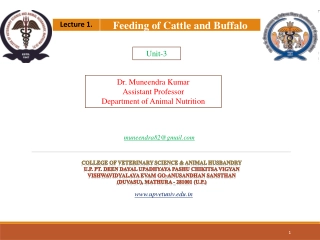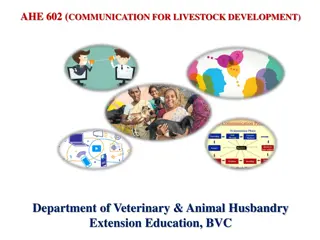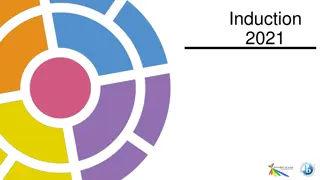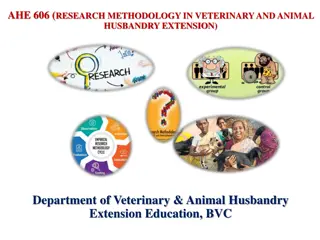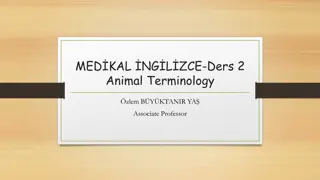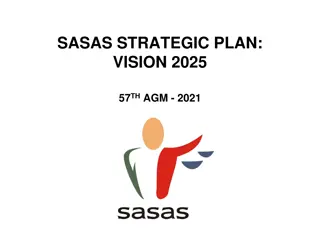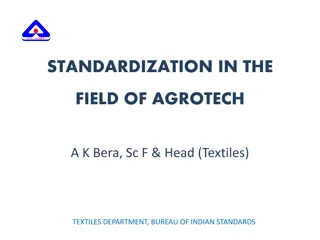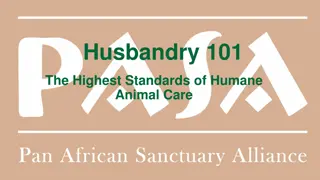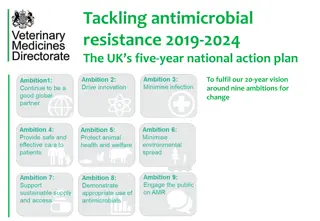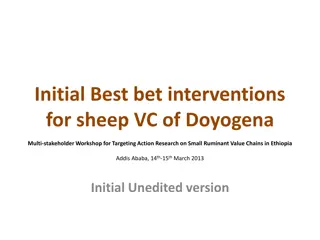Animal Husbandry Development Initiatives in India: Gaushalas and Gosadans
Animal Husbandry Development Programmes in India have a rich history dating back thousands of years, with initiatives like Gaushalas and Gosadans playing a significant role in preserving indigenous cattle breeds, promoting milk production, and supporting rural economies. Gaushalas aim to breed and upgrade Indian cows, provide unadulterated milk, and enhance draught work capabilities, while Gosadans were established to house uneconomic cattle. Despite challenges, these initiatives have contributed to the improvement of cattle and milk production in India.
Download Presentation

Please find below an Image/Link to download the presentation.
The content on the website is provided AS IS for your information and personal use only. It may not be sold, licensed, or shared on other websites without obtaining consent from the author. Download presentation by click this link. If you encounter any issues during the download, it is possible that the publisher has removed the file from their server.
E N D
Presentation Transcript
AHE 608 (Animal Husbandry Development Programmes) Dr. Pankaj Kumar Department of Veterinary & Animal Husbandry Extension Education, BVC
EFFORTS THROUGH SPECIFIC PROGRAMMES
GAUSALAS Engaged in rehabilitation of disowned cattle Set up Central Council of Govsamvardana (1952) Some of these gaushalas are providing quality indigenous / cross breds / heifers / bulls One gaushala at Bombay (1886) & has established two institutes One for research and Another for fodder research and grassland development. The Sabarmathi Ashram gaushala founded in 1915 by Mahatma Gandhi near Ahmedabad is now being managed by NDDB and has a training centre for AI service including embryo transfer.
Objectives of Gaushalas: To preserve the Indian cows and progeny and to breed and upgrade them for supplying plenty of unadulterated milk and milk products to the people and distribute the best female calves to the villagers. Prepare best pedigree Indian Bulls and supply to villagers for breeding and upgrading village cows. Production of best healthy bullocks for draught work and preserve male calves for distribution to agriculturists.
History The Gaushala movement practiced for the last 5000 years Yardstick for measuring economic esteem and prosperity Cow being the backbone of rural life and economy in India Grazing areas & grasslands were kept reserved in abundance everywhere. People used to donate their lands to Gaushalas on auspicious occasions ICAR (1946) recommended a plan to encourage them & to constitute state- wise federations of Gausalas & Pinjarapoles. Goshalas & Pinjarapoles managed by the community were still running. During First Five Year Plan, nearly 3,000 Gaushalas and Pinjarapoles maintained over 6 lakh cattle at an annual cost of Rs. 7 crores. Realized that, in spite of their drawbacks, serve as useful centres for the improvement of cattle and milk production, supplementing Government s efforts in this direction.
GOSADANS GOI appointed a Cattle Preservation and Development Committee on 19.11.1947 under the chairmanship of Sardar Datar Singh Recommended establishment of Gosadans where uneconomic cattle could be housed cheaply and allowed to die naturally. Planned to established 160 Gosadans during 1st five year plan The scheme was launched to solve the problem of degraded cattle. One Gosadan was designed to house 2000 cattle in a land of about 4000 acres. The scheme could not achieve the projected targets. Only 17 Gosadans could be started during the plan
KEY VILLAGE SCHEME A novel & systematic attempt made by independent India in August 1952 for development in cattle & buffalo The basic aim To bring about rapid improvement in the production potentiality to use improved breeding programme To provide effective healthcare, and scientific management and organized marketing facilities.
KVS programme included Introduction of superior bulls Castration of undesirable inferior bulls Use of artificial insemination Milk recording Improved fodder production Prevention and treatment of diseases Distribution of mineral feed supplements
KVS organizational structure Key Village Blocks included AI centre Four key village units
Reasons for failure of KVS Establishment of centers in the states where there were no recognized breeds Created confusion in the personnel of Animal Husbandry Departments (AHDs) by introducing lot of modifications in the scheme Inadequate attention paid to the fodder development and in establishment of marketing cells.








